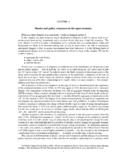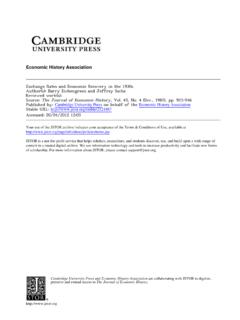Transcription of International Recessions - fperri.net
1 International Recessions By Fabrizio Perri and Vincenzo Quadrini . September 2017. Macro developments leading up to the 2008 crisis displayed an unprecedented degree of interna- tional synchronization. Before the crisis all G7 countries experienced credit growth, and around the time of the Lehman bankruptcy they all faced sharp and large contractions in both real and financial activity. Using a two-country model with financial frictions we show that a global liquid- ity shortage induced by pessimistic self-fulfilling expectations can quantitatively generate patterns like those observed in the data. The model also suggests that with more International financial integration crises are less frequent but, when they hit, they are larger and more synchronized across countries.
2 Keywords: Credit shocks , global liquidity, International co-movement JEL classification: F41, F44, G01. Perri: Research Division, Federal Reserve Bank of Minneapolis, 90 Hennepin Avenue, Min- neapolis, MN 55480-0291 (email: Quadrini: Department of Finance and Busi- ness Economics, Marshall School of Business, University of Southern California, 701 Exposition Boulevard, HOH 715, Los Angeles, CA 90089 (email: We thank Mark Aguiar and three anonymous referees for excellent comments, Philippe Bacchetta, Ariel Burstein, Fabio Ghironi, Jean Imbs, Anastasios Karantounias, Thomas Laubach, Enrique Mart nez-Garc a, Do- minik Menno, Paolo Pesenti, Xavier Ragot, Etsuro Shioji, and Raf Wouters for thoughtful discussions, and seminar participants at several institutions and conferences for very useful comments and suggestions.))
3 Perri acknowledges financial support from the European Research Council under Grant 313671. Quadrini acknowledges financial support from NSF Grant 1460013. The views expressed herein are those of the authors and not necessarily those of the Federal Reserve Bank of Minneapolis or the Federal Reserve System. The authors declare that they have no relevant or material financial interests that relate to the research described in this paper. One of the most striking features of the 2008 crisis is that in the midst of it during the quarter following the Lehman bankruptcy all major industrialized countries experienced ex- traordinarily large and synchronized contractions in both real and financial aggregates. Moti- vated by this evidence, we develop a simple theory of financial crises in open economies, aiming to make two contributions.
4 The first is to argue that the 2008 crisis could have been the result of a global liquidity shortage induced by pessimistic self-fulfilling expectations. We do so by showing that crisis patterns predicted by our theory are quantitatively consistent with many features of the macro-economy observed before and during the 2008 crisis in the and other G7 countries. The second contribution is to show how International financial integration affects the probability and the size of crises. In particular with more International financial integra- tion crises are less frequent but, when they hit, they are larger and more synchronized across countries. This finding can have important normative implications, in light of the recent policy debate on the desirability of capital markets integration.
5 Our analysis is based on a two-country model where firms in both countries use credit to finance hiring and investment, and where the availability of credit depends on the value of collateral, that is, the resale price of assets. The value of collateral is endogenous in the model and depends on the market liquidity (access to credit) which in turn depends on the value of collateral. This interdependence between the value of collateral and liquidity creates the conditions for which the tightness of credit constraints can emerge endogenously as multiple self-fulfilling equilibria. In good' equilibria, the market expects high resale prices for the assets of defaulting firms, which allows for looser borrowing constraints. As a result of the high borrowing capacity, firms are not liquidity constrained and ex post there are firms with the required liquidity to purchase the assets of defaulting firms.
6 This keeps the resale price high and rationalizes, ex post, the ex ante expectation of high collateral values. The higher availability of credit in good equilibria also means that firms borrow more. As credit expands, however, a bad' equilibrium could emerge if market expectations about the resale price of assets change and turn pessimistic. Expectations of a low resale value implies that firms face tighter borrowing limits and are liquidity constrained. Because firms are liquidity constrained, there are no firms capable of purchasing the assets of defaulting firms and, as a result, the resale price is low. This rationalizes the expectation of 1. low prices, leading to bad' equilibria characterized by globally reduced credit, deleveraging, and sharply depressed real activity.
7 Financial integration implies that the prices of collateral are equalized across countries, and hence credit conditions are also equalized. It is through this mechanism that the crisis becomes global and displays a high degree of real and financial synchronization. The theory of endogenous financial booms and busts is important in two respects. First, with endogenous credit shocks the model generates cross-country co-movement not only in real variables but also in financial aggregates. To show this, we first study a version of the model in which country-specific credit conditions change exogenously. If financial markets are integrated, an exogenous tightening of credit in one country depresses employment and output in both countries. However, while the country hit by the shock experiences a credit crunch, the other country experiences a credit boom.
8 Therefore, unless exogenous credit shocks are correlated across countries, the model would not generate financial synchronization. We then show that by making credit conditions endogenous, the model generates synchronized movements in both real and financial variables. This result supports the view that a self-fulfilling, global liquidity shortage, rather than isolated country-specific shocks , is important for understanding the 2008. crisis. Second, the endogeneity of credit booms and busts allows us to assess how the probability and depth of crises change when financial markets get more integrated. Since a self-fulfilling crisis requires a high degree of coordination in expectations, the likelihood of coordination de- creases when markets are integrated: an integrated market is a larger market that requires the coordination of more agents.
9 But as the probability of a crisis decreases, the incentive to lever- age increases. Thus with integrated financial markets crises are less frequent, but their macro consequences are bigger. In the final part of the paper we evaluate the quantitative importance of liquidity induced crises by calibrating the model to the United States and other G7 countries. The simulation over the period 1995-2012 shows that the model captures several features of real and financial data not only during the crisis but also in the period that preceded the crisis. The setup also helps us understand a number of features that are hallmarks of financial crises in general. In particular, the model generates (i) asymmetric dynamics of real variables in credit booms (slow 2.)
10 Growth) and credit crashes (sharp contraction), (ii) countercyclical labor productivity, and (iii). crises that are more severe when they arise after a long period of credit expansion. However, the model does not capture the sluggish recovery after the crisis. This suggests that a liquidity shortage can be responsible for the initial collapse in economic activity typical of a financial crisis, but additional mechanisms are needed to understand the sluggish recovery that typically follows the crisis. One important observation concerning the International dimension of the recent crisis is that employment was hit particularly hard in the United States but, at least initially, not in the other G7 countries. Also, labor productivity did not change significantly in the United States but declined in the other G7 countries.





